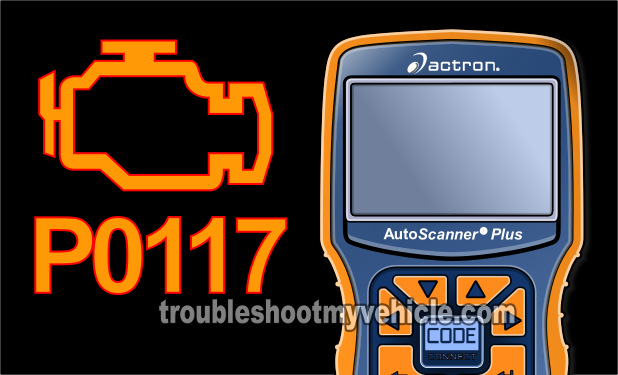
OBD II trouble code P0117 ECT Sensor Circuit Low Voltage is telling you that your Honda's fuel injection computer is seeing a continuous engine coolant temperature of 300°F (150°C) or higher.
The two most common causes of a P0117 trouble code is either a bad ECT sensor or a short in the sensor's wires. In this tutorial, I'm gonna' help you troubleshoot this diagnostic trouble code (DTC) in a step-by-step way.
Contents of this tutorial:
- P0117 Basics You Need To Know.
- How The ECT Sensor Works.
- Symptoms Of A P0117 Diagnostic Trouble Code.
- Common Causes Of A P0117 Trouble Code.
- START HERE: Troubleshooting DTC P0118.
- TEST 1: Checking The Engine Coolant Temperature Value.
- TEST 2: Checking The Condition Of The ECT Sensor's 2 Wires.
- TEST 3: Disconnecting The ECT Sensor From Its Connector.
- More Honda 2.2L, 2.3L Test Tutorials.
P0117 Basics You Need To Know
From the moment your Honda starts till when you finally turn it off, your Honda's PCM needs several sensor inputs to control the amount of fuel it injects into the engine.
The engine coolant temperature, that the ECT sensor provides, is one of those basic sensor inputs it needs to keep the engine running efficiently and optimally.
Why is the engine coolant info so important? Because the colder the engine is, the more fuel the fuel injection computer (known as the PCM = Powertrain Control Module) needs to inject. The warmer the engine is, the less fuel the PCM is needs to inject.
So when the PCM gets the wrong engine coolant temperature... it can no longer control fuel injection to maximize performance and decrease emissions.
Now, when a code P0117 ECT Sensor Circuit Low Voltage lights up the check engine light (CEL) on your Honda's instrument cluster, the PCM is letting you know that it sees an engine coolant temperature of 300°F (150°C) or hotter.
How The ECT Sensor Works
Although a P0117 ECT Sensor Circuit Low Voltage doesn't necessarily accuse the engine coolant temperature (ECT) sensor as bad... it does help to know how the ECT sensor operates and reports the engine's coolant temperature.
Briefly, this is how the engine coolant temperature (ECT) sensor works:
- The engine coolant temperature (ECT) sensor is a 2 wire sensor.
- One wire (circuit) supplies power.
- Power is in the form of 5 Volts DC and is provided only with Key On Engine Off (KOEO) or Key On Engine Running (KOER).
- Power is provided by the PCM.
- The other wire (circuit) supplies Ground.
- This Ground is fed to the ECT sensor by the PCM (internally).
- One wire (circuit) supplies power.
- The ECT sensor is a resistor (thermistor). Its resistance changes in response to changes in the engine's coolant temperature.
- The cooler the engine coolant, the higher the resistance of the ECT sensor.
- The warmer the engine coolant, the lower the resistance of the ECT sensor.
- When the 5 Volts pass through the engine coolant temperature (ECT) sensor, the resistance of the sensor produces a voltage drop. This in plain English means that only a certain amount of the 5 Volts are let through to the Ground wire.
- The cooler the engine coolant is, the less voltage is let thru' onto the Ground wire (due to the ECT sensor's higher resistance).
- The PCM translates this higher voltage drop into a colder temperature value.
- The warmer the engine coolant, the more Voltage is let thru' onto the Ground wire (due to the ECT sensor's lower resistance).
- The PCM translates this lower voltage drop into a warmer/hotter temperature value.
- The cooler the engine coolant is, the less voltage is let thru' onto the Ground wire (due to the ECT sensor's higher resistance).
With this bit of information, let's move on to the next subheading.
Symptoms Of A P0117 Diagnostic Trouble Code
You'll notice several symptoms when your Honda's PCM doesn't receive correct engine coolant temperature info.
You may see one or more of the following symptoms when the engine coolant temperature (ECT) sensor fails:
- Check engine light (CEL) is on.
- DTC P0117 is present.
- Won't pass the state mandated emissions test.
- Gas mileage will suffer.
- Hard start and/or extended cranking time (after shut off).
- Black smoke coming out of the tailpipe.
Let's find out what are the common causes of a P0117 DTC, in the next subheading.
Common Causes Of A P0117 Trouble Code
The 2 most common cause of trouble code P0117 are:
- A bad engine coolant temperature (ECT) sensor.
- A problem in the sensor 2 wires.
Although extremely rare for this to happen... a bad PCM can also cause a false P0117 trouble code.
In this tutorial, I'll help you troubleshoot all three of the above. With this basic info under our belts, let's turn the page and get testing!
